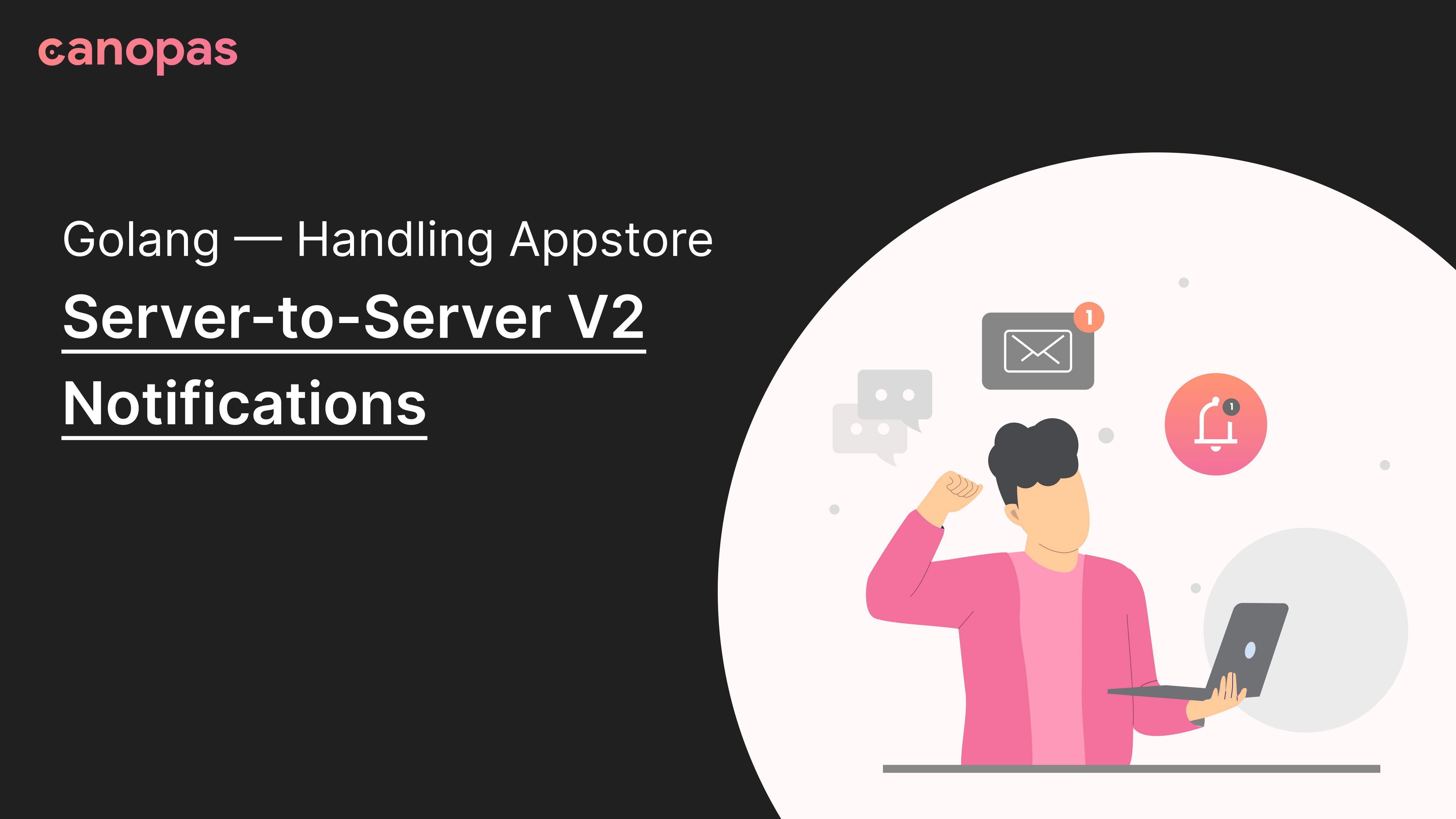
Golang — Handling Appstore Server-to-Server V2 Notifications
Introduction
App Store has released server-to-server notification version 2 with more events(notification types and sub-types) than version 1.
In version 2, they are sending JSON Web Signature (JWS) formatted (Which is a JWT token) notification to improve the security of data.
In this article, we will show how to decode SNS notifications v2 in a Go application.
Background
When I started implementing app store SNS v2 in golang, I was a bit confused about how to verify and parse JWS data.
Thanks to this thread, I learned lots of important things there. While doing the implementation, I simplified it to make understanding easier.
This article will help you learn about SNS implementation in a very simple way.
Before beginning with the actual implementation, let’s get familiar with the request body of the notification we get from Apple first!
Sponsored
We are what we repeatedly do. Excellence, then, is not an act, but a habit. Try out Justly and start building your habits today!
Notification V2 request body
{
"signedPayload":"eyJhbGciOiJFUzI1NiIsIng1YyI6WyJNSUlFTURDQ0E3YWdBd0lCQWdJUWFQb1BsZHZwU29FSDBsQnJqRFB2OWpBS0JnZ3Foa2pPUFF..."
}It’s signed by the App Store and contains all required data including transaction info and renewal info of app store purchases.
FYI : You can parse and review
signedPayloadon jwt.io
Whenever we receive a notification from the app store, we need to first verify the request and then we need to parse that token to get payload data.
JWS contains 3 parts in the token separated by .
- Header (contains two fields :
AlgorithmandToken type) - Payload (contains data)
- Signature
For verifying the request we need to parse the header part. If it's verified successfully, then we will parse the payload otherwise decline it.
We have divided the decoding process of signedPayload in the following steps —
- Extract header from JWS token
- Verify the header with an app store key
- Extract the public key from the token to parse payload data
- Prepare structures to bind notification
- Parse payload and bind it to structures
Let’s learn it step by step.
1. Extract header from JWS token
First, we will define the structure to get a header with two fields algorithm and token type.
- Algorithm: ES256
- Token type: x5c (X.509 certificate chain) contains the X.509 public key certificate or certificate chain [RFC5280] corresponding to the key used to digitally sign the JWS.
// prepare header structure contains algorithm and token type
type NotificationHeader struct {
Alg string `json:"alg"`
X5c []string `json:"x5c"`
}
// extract header from given JWS formatted token
func extractHeaderByIndex(tokenStr string, index int) ([]byte, error) {
tokenArr := strings.Split(tokenStr, ".") // get header from token
headerByte, err := base64.RawStdEncoding.DecodeString(tokenArr[0]) //convert header to byte
if err != nil {
return nil, err
}
var header NotificationHeader
err = json.Unmarshal(headerByte, &header) // bind byte to header structure
if err != nil {
return nil, err
}
certByte, err := base64.StdEncoding.DecodeString(header.X5c[index]) //decode x.509 cerificate headers to byte
if err != nil {
return nil, err
}
return certByte, nil
}Let’s understand it,
- strings.Split: split the string by
.and extract the first part of the split array which is a header. - base64.RawStdEncoding.DecodeString(tokenArr[0]) decodes the base64 header string to a byte with raw encoding.
- Unmarshal bytes to go structure which is
NotificationHeader. We need to use X5c of structure to get the certificate. X5cis an array of 3 elements which is a certificate chain.X5c[0]: use for extracting public keyX5c[1]: intermediate certificate used to verify the headerX5c[2]: root certificate used to verify the header
2. Verify the header with an app store key
In this step, we will verify the X5c certificates using the app store key, which we can download from Apple Root CA — G3 Root.
Convert it to PEM using the following command.
openssl x509 -in AppleRootCA-G3.cer -out cert.pemVerify the X5c certificate using the app store key.
func verifyCert(certByte []byte, intermediateCert []byte) error {
roots := x509.NewCertPool() // new empty set of certificate pool
ok := roots.AppendCertsFromPEM([]byte(APP_STORE_NOTIFICATION_ROOT_CERT)) // parse and append app store certificate to certPool
if !ok {
return errors.New("failed to parse root certificate")
}
interCert, err := x509.ParseCertificate(intermediateCert) // parse and append intermediate X5c certificate
if err != nil {
return errors.New("failed to parse intermediate certificate")
}
intermediate := x509.NewCertPool()
intermediate.AddCert(interCert)
cert, err := x509.ParseCertificate(certByte) // parse X5c certificate
if err != nil {
return err
}
opts := x509.VerifyOptions{ // append certificate pool to verify options of x509
Roots: roots,
Intermediates: intermediate,
}
if _, err := cert.Verify(opts); err != nil { // verify X5c certificate using app store certificate resides in opts
return err
}
return nil
}- x509.NewCertPool() will create a new and empty certificate pool, and we will append the app store cert to this pool.
- APP_STORE_NOTIFICATION_ROOT_CERT is converted
PEM keyfrom the app store certificate. Copy the PEM key from the file and assign it here. - roots.AppendCertsFromPEM parse and append the PEM key to the cert pool.
- We also parse and append intermediate certificates to the certificate pool.
- x509.ParseCertificate(certByte) parses extracted
X5ccertificate. - x509.VerifyOptions prepare x509 verify options.
- cert.Verify(opts) verifies X5c certificate using verifyOptions.
3. Extract the public key from the token to parse payload data
Now we have verified the notification request, it's time to parse payload data. For that, we need a public key. Let’s get that from the header.
func extractPublicKeyFromToken(tokenStr string) (*ecdsa.PublicKey, error) {
certStr, err := extractHeaderByIndex(tokenStr, 0) // get certificate from X5c[0] header
if err != nil {
return nil, err
}
cert, err := x509.ParseCertificate(certStr) // parse certificate
if err != nil {
return nil, err
}
switch pk := cert.PublicKey.(type) { // get public key
case *ecdsa.PublicKey:
return pk, nil
default:
return nil, errors.New("appstore public key must be of type ecdsa.PublicKey")
}
}We have reused code from step 1 and step 2 and extract the public key from the header.
- Get the certificate from
extractHeaderByIndexmethod. - Parse certificate string to bytes.
- Extract
ecdsa.PublicKeyfrom certificate bytes.
That’s it. You will have the public key now.
4. Prepare structures to bind notification
When we parsed the JWS token on jwt.io, we see that the payload has some fields. We will define go structures for required fields from those fields.
From the payload, I have identified 3 basic structures that we will require to change the user’s subscription status.
- NotificationPayload
- TransactionInfo
- RenewalInfo
// Notification signed payload
type NotificationPayload struct {
jwt.StandardClaims
NotificationType string `json:"notificationType"`
Subtype string `json:"subtype"`
NotificationUUID string `json:"notificationUUID"`
NotificationVersion string `json:"notificationVersion"`
Data NotificationData `json:"data"`
}
// Notification Data
type NotificationData struct {
jwt.StandardClaims
AppAppleID int `json:"appAppleId"`
BundleID string `json:"bundleId"`
BundleVersion string `json:"bundleVersion"`
Environment string `json:"environment"`
SignedRenewalInfo string `json:"signedRenewalInfo"`
SignedTransactionInfo string `json:"signedTransactionInfo"`
}
// Notification Transaction Info
type TransactionInfo struct {
jwt.StandardClaims
TransactionId string `json:"transactionId"`
OriginalTransactionID string `json:"originalTransactionId"`
WebOrderLineItemID string `json:"webOrderLineItemId"`
BundleID string `json:"bundleId"`
ProductID string `json:"productId"`
SubscriptionGroupIdentifier string `json:"subscriptionGroupIdentifier"`
PurchaseDate int `json:"purchaseDate"`
OriginalPurchaseDate int `json:"originalPurchaseDate"`
ExpiresDate int `json:"expiresDate"`
Type string `json:"type"`
InAppOwnershipType string `json:"inAppOwnershipType"`
SignedDate int `json:"signedDate"`
Environment string `json:"environment"`
}
// Notification Renewal Info
type RenewalInfo struct {
jwt.StandardClaims
OriginalTransactionID string `json:"originalTransactionId"`
ExpirationIntent int `json:"expirationIntent"`
AutoRenewProductId string `json:"autoRenewProductId"`
ProductID string `json:"productId"`
AutoRenewStatus int `json:"autoRenewStatus"`
IsInBillingRetryPeriod bool `json:"isInBillingRetryPeriod"`
SignedDate int `json:"signedDate"`
Environment string `json:"environment"`
}SNS v2 has included notification types along with subtypes to get detailed information about subscription status.
You can understand all the fields on the app store’s official documentation.
You have noticed jwt.StandardClaims in all the structures as we need them to parse JWS data.
Let’s go to the final step.
5. Parse payload and bind it with structures
/** payload data **/
payload := &NotificationPayload{}
_, err = jwt.ParseWithClaims(tokenStr, payload, func(token *jwt.Token) (interface{}, error) {
return extractPublicKeyFromToken(tokenStr)
})
/** transaction info **/
transactionInfo := &TransactionInfo{}
tokenStr := payload.Data.SignedTransactionInfo
_, err = jwt.ParseWithClaims(tokenStr, transactionInfo, func(token *jwt.Token) (interface{}, error) {
return extractPublicKeyFromToken(tokenStr)
})
/** renewal info **/
renewalInfo := &RenewalInfo{}
tokenStr := payload.Data.SignedRenewalInfo
_, err = jwt.ParseWithClaims(tokenStr, renewalInfo, func(token *jwt.Token) (interface{}, error) {
return extractPublicKeyFromToken(tokenStr)
})Here, We have used the public key method from step 3 to parse the JWS token string.
- In notificationPayload, we have parsed the main
signedPayloadstring. It has adatafield, which containstransactionInfoandrenewalInfoin JWS format string. - In TransactionInfo, we have parsed
data.transactionInfostring. - In renewalInfo, we have parsed
data.renewalInfostring.
Final method
The above steps are used to decode the notification payload signed by the app store.
But we have to do that in order as we have discussed earlier, if the certificate is verified, then only we will parse the data otherwise decline it.
func parseJwtSignedData(tokenStr string) error {
rootCertStr, err := extractHeaderByIndex(tokenStr, 2) // get root cert from X5c header
if err != nil {
return err
}
intermediateCertStr, err := extractHeaderByIndex(tokenStr, 1) // get intermediate cert from X5c header
if err != nil {
return err
}
/** verify certs. if not verified, return err **/
if err = verifyCert(rootCertStr, intermediateCertStr); err != nil {
return err
}
/** payload data **/
payload := &NotificationPayload{}
_, err = jwt.ParseWithClaims(tokenStr, payload, func(token *jwt.Token) (interface{}, error) {
return extractPublicKeyFromToken(tokenStr)
})
/** transaction info **/
transactionInfo := &TransactionInfo{}
tokenStr = payload.Data.SignedTransactionInfo
_, err = jwt.ParseWithClaims(tokenStr, transactionInfo, func(token *jwt.Token) (interface{}, error) {
return extractPublicKeyFromToken(tokenStr)
})
/** renewal info **/
renewalInfo := &RenewalInfo{}
tokenStr = payload.Data.SignedRenewalInfo
_, err = jwt.ParseWithClaims(tokenStr, renewalInfo, func(token *jwt.Token) (interface{}, error) {
return extractPublicKeyFromToken(tokenStr)
})
return nil
}Now we have payload, transactionInfo and renewalInfo, Using these data we can update the user’s subscription status based on the notificationType and it’s subType .
Conclusion
That’s it for today. Hope you have an understanding of how we can decode SNS v2 notification data and use it on the server. Similar way, you can implement SNS v2 in any backend language like Ruby, PHP, or Python.
You can refer to app store documentation to decide what user’s data you have to update at your backend from notification.
We’re Grateful to have you with us on this journey!
Suggestions and feedback are more than welcome!
Please reach us at Canopas Twitter handle @canopassoftware with your content or feedback. Your input enriches our content and fuels our motivation to create more valuable and informative articles for you.
Related articles



Whether you need...
- *High-performing mobile apps
- *Bulletproof cloud solutions
- *Custom solutions for your business.